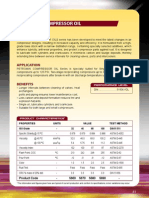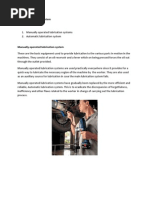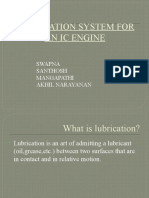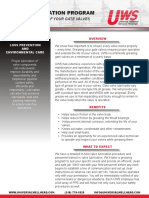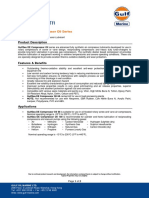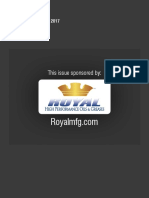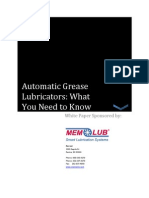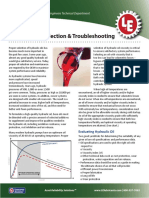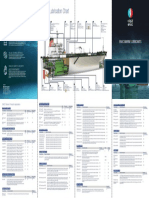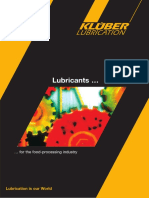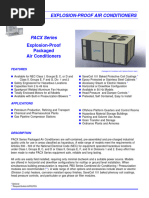Concept of Automatic Lubrication System and Comparison With Conventional Lubrication System
Concept of Automatic Lubrication System and Comparison With Conventional Lubrication System
Uploaded by
Herrera Jorge AgustínCopyright:
Available Formats
Concept of Automatic Lubrication System and Comparison With Conventional Lubrication System
Concept of Automatic Lubrication System and Comparison With Conventional Lubrication System
Uploaded by
Herrera Jorge AgustínOriginal Title
Copyright
Available Formats
Share this document
Did you find this document useful?
Is this content inappropriate?
Copyright:
Available Formats
Concept of Automatic Lubrication System and Comparison With Conventional Lubrication System
Concept of Automatic Lubrication System and Comparison With Conventional Lubrication System
Uploaded by
Herrera Jorge AgustínCopyright:
Available Formats
Special Issue - 2017 International Journal of Engineering Research & Technology (IJERT)
ISSN: 2278-0181
NCIETM - 2017 Conference Proceedings
Concept of Automatic Lubrication System and
Comparison with Conventional Lubrication
System
Agam Kumar Malik1, Ankit Singh2, Mohit Hooda3
Graduate Student,
Department of Mechanical Engineering,
NCCE Israna,Panipat1,2,3
Abstract— Lubrication plays a major role in reducing in lubricate multiple points on a machine. These systems
friction between the piston and shear of moving mechanical dimensions vary from a simple single-port lubricator to
components to enhance the engine performance and complex dual-line, overturn units employing timers and
efficiency. This paper deals with the study and comparison alarms to deliver grease reliably to hundreds of grease
of Automatic Lubrication System with conventional
points. The design parameters of centralized grease
lubrication system. Automatic lubrication systems provide
a safer, more accurate form of machine lubrication. systems include the volume and frequency of grease
An automatic lubrication system (ALS), is defined as required at each point, the number of notch requiring
a centralized lubrication system, is a system that delivers grease, performing conditions, pump pressure, line
metered quantity of lubricant to multiple locations on a diameter and span to the grease points. When used and
engine while the engine is operating. The conventional preserved properly, centralized grease systems can help
lubrication system composed of manual lubricating to enhance technician productivity and simplify equipment
various parts of the engine. This system is usually time maintenance processes. The following is a complete
consuming. Previously we have to shut down system for
overview of centralized grease systems and the assistance
greasing. This study includes design and manufacturing of
automatic lubrication system, which allows to do greasing at
they offer, the various types, matter to watch out for and
frequent interval of time and in adequate amount. This tips on how to maintain them properly.
lubrication also ensures safety to machine components and
reduces labour. It ensures proper lubrication to each and II. AUTOMATIC LUBRICATION SYSTEM
every part of the engine. Centralized grease systems are designed principally to
make the work environment safer for maintenance
Index Terms- Automatic lubrication system, Oil systems, personnel by simplifying the process of accessing remote
Conventional lubrication system, Engine lubricant grease points, especially in restricted spaces, when
equipment is in operation. However, the primary use is
I. INTRODUCTION
derived from the continuous application of small amounts
The development of lubrication and its application in
of grease resulting in improved equipment life, due to the
machine and engine components in general, began in early
uniform supply of grease. Hand application is typically
70's of last century. From the view of improving
performed infrequently and may result in uneven amounts
lubrication in recent years more and more stress is given
of grease being applied, which can lead to over greasing
on the constant increase in materials and lubricants
resulting in damaged seals and elevated bearing
performance. The lubrication can be defined as a process
temperatures caused by grease churn
by which we introduce a layer of lubricant to reduce
Components
friction and reduces the wear between the two surfaces,
which are in relative motion to each other. This process A typical system consists of controller/timer, pump
includes the following activities: -the cleaning of w/reservoir, supply line, calculating valves, and feed
lubricants,- the checking the quantity of lubricants, - lines. All automatic lubrication systems share these main
refilling lubricants, Choosing the components:
with the correct lubrication system ensures firmness and 1. Controller/Timer –manages the pressure on the
allocates lubricants are best for a particular use. The system by turning pressure supply valves on and
abandonment machines will be avoided and the cost of off on the basis of either time or cycle. It can also
system maintenance will be drastically reduced. receive signals demonstrating restricted or failed
Automatic lubrication system (ALS), defined as a grease flow to the bearing.
centralized lubrication system, is a system that provides
metered amounts of lubricant to multiple locations on a 2. Reservoir – provides a total quantity of grease
machine while the machine is operating. Centralized that can be kept clean and readily available to the
grease lubrication systems are widely used in industrial system.
and heavy-duty mobile equipment applications to
Volume 5, Issue 11 Published by, www.ijert.org 1
Special Issue - 2017 International Journal of Engineering Research & Technology (IJERT)
ISSN: 2278-0181
NCIETM - 2017 Conference Proceedings
3. Pump – the flow of grease and builds up pressure A Single Line Parallel Lubrication Systems primarily
in the line(s). Pump size will vary banking on the consist of:
distance between the pump and the farthest - A Pump with either integral reservoir or with grease
injector. barrel mounting option
4. Metering Valves/Injectors– unit that take the - Air Maintenance Unit
lubricant to the application points. - Appropriate Injector devices
5. Feed lines - line that connects the metering - Electronic Control Unit (Timer)
valves or injectors to the application points. - Appropriate Tubing, Fittings, Valves and Gauges
Types
There are numerous different types of automatic During the operation cycle, the pre-set quantity of
lubrication systems including: lubricant is pumped to the various injector devices, which
Single Line Parallel systems in turn deliver the pre-set quantities of the lubricant to the
connected lubrication points. The injector devices are
Dual Line Parallel systems connected in parallel & operate independent of each
Single Point Automatics other. The sequence of operation can be controlled by the
electronic control unit (Timer).
Single Line Progressive systems
Single Line Resistance Dual line parallel
The most commonly used Automatic Lubrication System
types are:
Single Line Parallel,
Dual Line Parallel and
Single Line Progressive Multi port direct
lubricators
Single line progressive
Figure-3 Dual Line Parallel Automatic Lubrication System
A dual line parallel system is similar to the single line
parallel system in that it uses hydraulic pressure to cycle
adjustable valves to dispense measured shots of lubricant.
Figure 1- Single Line Progressive Automatic Lubrication System
It has 2 main supply lines which are alternatively used as
pressure / vent lines. The advantage of a two-line system is
In a single line parallel system, lubricant can be supplied that it can handle hundreds of lubrication points from a
either manually, with a grease gun, or with the help of a single pump station over several thousand feet using
fully automated system using electric or pneumatic pumps significantly smaller tubing or pipe. Operation begins
and progressive metering valves. More than a drilled when the controller/timer sends a signal to the pump to
manifold block, the SSV metering valve covers a series of start the lubrication cycle. The pump begins pumping
metering pistons, which accurately distributes lubricant lubricant to build up pressure in the first (the pressure)
from each outlet. Observable monitoring is provided with supply line while simultaneously venting the second
an indicator pin, which certifies a valve has completed a (vent) return line. Once the required pressure is reached, a
full cycle. predetermined amount of lubricant is dispensed by the
Single line parallel metering devices to half of the lubrication points via feed
lines. Once the pressure switch monitoring main supply
line pressure indicates a preset pressure in the line has
been reached, the system is hydraulically closed. The
controller shuts off the pump and signals a changeover
valve to redirect lubricant to the second main supply line.
The next time the controller activates the system, the
second main line now becomes the pressure line while the
first line becomes the vent line. The second line is
pressurized and the entire process is repeated lubricating
the remaining lube points.
Figure-2 Single Line Parallel Automatic Lubrication System
Volume 5, Issue 11 Published by, www.ijert.org 2
Special Issue - 2017 International Journal of Engineering Research & Technology (IJERT)
ISSN: 2278-0181
NCIETM - 2017 Conference Proceedings
Multi point direct lubricator IV. CONVENTIONAL LUBRICATION SYSTEM AND
COMPARISON WITH AUTOMATIC LUBRICATION SYSTEM
When the controller in the pump or external controller
Lubricate
activates the drive motor, a set of cams turns and activates
Reduces Friction by creating a thin film(Clearance)
individual injectors or pump elements to dispense a fixed
between moving parts (Bearings and journals).
amount of lubricant to each individual lubrication point.
Purpose of Lubrication System
Systems are easy to design, direct pump to lube point
•Seals The oil helps form a gastight seal between piston
without added accessories and easy to troubleshoot.
rings and cylinder walls (Reduces Blow-By) Internal oil
III. LITERATURE SURVEY leak (blow-by) will result in BLUE SMOKE at the tale
Review pipe.
There are many claims to the invention of the differential •Cleans As it circulates through the engine, the oil picks
gear but it is likely that it was known, at least in some up metal particles and carbon, and brings them back down
places, in ancient times. Some historical milestones of the to the pan.
differential include Two Chinese Buddhist monks and . •Cools Picks up heat when moving through the engine
engineers create South Pointing Chariots for Emperor and then drops into the cooler oil pan, giving up some of
Tenji of Japan. Documented Chinese reproductions of the this heat.
South Pointing Chariot by Yan Su and then Wu Deren, Absorbs shock When heavy loads are imposed on the
which described in detail the mechanical functions and bearings, the oil helps to cushion the load. •Absorbs
gear ratios of the device much more so than earlier Contaminants The additives in oil helps in absorbing the
.Chinese record Joseph Williamson used a differential contaminants that enter the lubrication system.
gear in a clock in the year1720. Rudolph Ackermann of
Germany inventeda four wheel steering system for
carriages, which some later writers mistakenly reported as
a differential in the year 1810. Modern automotive
differential patented by watchmaker On Siphore Pecqueur
in the period 1792-1852 of the Conservatoire des Arts Et
Mtiers in France for use on a steam carts Richard Roberts
of England patented gear of Compensation', a differential
for road locomotives in1832 Aveling and Porter of
Rochester, Kent list a crane locomotive in their catalogue
fitted with their patent differential gear on the rear axle in
the year 1874 First use of differential on an Australian
steam car by David Shearer was done in 1897. Packard
introduces the spiral gear differential, which cuts gear
noise in the year 1913. Packard introduced the hypoid
differential, which enable the propeller shaft and its hump
in the interior of the car to be lowered in1926. Vernon
Gleasman patented the Torsen dual drive differential, a
type of limited slip differential that relies solely on the
action of gearing instead of a combination of clutches and Figure-4 Conventional lubrication system
gears was introduced in the year 1958 The Engine lubrication system is considered to give a flow
Concept to the clean oil at the accurate temperature, with a
In project we have to develop the Automatic Lubrication appropriate pressure to each part of the engine. The oil is
System by using pneumatic cylinder and grease gun. It is sucked out into the pump from the sump, as a heart of the
less costly than the LINCOLN. It is less costlier than system, than forced between the oil filter and pressure is
automatic lubrication system based on hydraulics which fed to the main bearings and also to the oil pressure gauge.
was developed by LINCOLN The double acting The oil passes through the main bearings feed- holes into
pneumatic cylinder connected to handle of grease gun and the drilled passages which is in the crankshaft and on to
its other end is connected to compressor. When the bearings of the connecting rod. The bearings of the
compressor starts which deliver pressure at about 3 bar, it piston-pin and cylinder walls get lubricated oil which
moves the handle of grease gun to downward. And it dispersed by the rotating crankshaft. By the lower ring in
actuates the secondary piston of grease gun which delivers the piston the excess being scraped. Each camshaft
grease to required greasing point through nozzles bearing is fed by the main supply passage from a branch or
provided. When handle reaches to limit switch, it get tributary. And there is another branch which supplies the
actuated. Actuation of limit switch makes the pneumatic gears or timing chain on the drive of camshaft. The oil
cylinder operated oppositely. . Hence grease handle which is excesses then drains back to the sump, where the
occupies its original position. The whole process heat is being transferred to the surrounding air.
continues up to the time provided by digital timer.
Volume 5, Issue 11 Published by, www.ijert.org 3
Special Issue - 2017 International Journal of Engineering Research & Technology (IJERT)
ISSN: 2278-0181
NCIETM - 2017 Conference Proceedings
Comparison of manual and automatic greasing: There V. CONCLUSION
are certainly advantages to automatic application when From the Automatic Lubrication system it is concluded
compared to manual application. Theoretically, it is that the cost and man power require for the lubricating
preferable to apply small amounts of grease at short the various grease points can be eliminated. The loss of
intervals rather than large amounts of grease at long grease during greasing reduces as compared with the
intervals. With manual application, the trick is to apply as manual greasing. The system provides safety to the
much grease as possible without causing harm due to lubricating component and the operator. This system
over-greasing, thereby maximizing the re-lubrication enables the greasing to the points which are not reachable
interval. While this is fine for most grease-lubricated to operator and down time also reduces.
components, there are many applications that may benefit
from more frequent application or could be harmed by REFERENCES
large application volumes. There are lots of problems with [1] Gavaerts, R.: The World of Automatic Lubrication PERMA, 2009.
manual greasing such as 1) There is excessive loss of [2] Scarlett, N.A. (1967), “Use of Grease in Rolling Bearings,” Proc.
grease. 2) Equipment getting harmed due to over greasing. IMechE. Part 3A, 182, pp 167-171.
[3] H. Mikami: "Latest Trends in Lifespan Prediction for Lubrication
3) Excess time lost in lubrication. 4) Requiring variable
Grease and Grease," Hydraulics & Pneumatics (Japan).
labours [4] Ito, H., Koizumi, H., and M. Naka. (1995), “Grease Life Equations
Benefits for Sealed Ball Bearing.
Auto lube systems have many advantages over
conventional methods of manual lubrication:
1. All critical components are lubricated,
regardless of position or ease of access
2. Lubrication occurs while the machinery is in
operation causing the lubricant to be equally
distributed within the bearing and increasing the
machine’s availability.
3. Proper lubrication of critical components
ensures safe operation of the machinery.
4. Less wear on the components means extended
component life, fewer breakdowns, reduced
downtime, reduced replacement costs and
reduced maintenance costs
5. Measured lubrication amounts means no wasted
lubricant
6. Safety - no climbing around machinery or
inaccessible areas (gases, exhaust, confined
spaces, etc.)
7. Lower energy consumption due to less friction
8. Increased overall productivity resulting from
increase in machine availability and reduction in
downtime due to breakdowns or general
maintenance
Volume 5, Issue 11 Published by, www.ijert.org 4
You might also like
- AOD Transmission SchematicDocument3 pagesAOD Transmission Schematicparadox1000160% (5)
- GROUP 3 - Mülimatt Sports Education and Training CentreDocument19 pagesGROUP 3 - Mülimatt Sports Education and Training CentreAayushi Pansara100% (2)
- GH Bladed Theory ManualDocument88 pagesGH Bladed Theory ManualCFDiran.ir100% (2)
- API Valves Standards PDFDocument1 pageAPI Valves Standards PDFDodi SuhendraNo ratings yet
- Grade 4 - Pulleys and Gears Unit PlanDocument9 pagesGrade 4 - Pulleys and Gears Unit Planapi-31184874550% (2)
- Shell Paper Mill OilsDocument29 pagesShell Paper Mill Oilsbiron rumangun100% (1)
- Compressor OilDocument1 pageCompressor OilWasimraja NanjwaniNo ratings yet
- Thermo-Hydraulic Design of Earth-Air Heat ExchangersDocument9 pagesThermo-Hydraulic Design of Earth-Air Heat ExchangersHerrera Jorge AgustínNo ratings yet
- Equivalences FixationsDocument30 pagesEquivalences FixationsFred100% (4)
- Lubricating System and Cooling SystemDocument20 pagesLubricating System and Cooling SystemAlliah MacahilasNo ratings yet
- Lubrication SystemsDocument9 pagesLubrication SystemsCeno EdwinNo ratings yet
- Chapter 6 - Lubricating SystemDocument29 pagesChapter 6 - Lubricating SystemEugine BalomagaNo ratings yet
- Types of Lubrication SystemDocument13 pagesTypes of Lubrication SystemPawan Paramanandan100% (2)
- Automatic Lubrication SystemDocument4 pagesAutomatic Lubrication SystembalabooksNo ratings yet
- Automatic Lubrication Systems: Enhancing Uptime. Increasing Production. Expanding OptionsDocument4 pagesAutomatic Lubrication Systems: Enhancing Uptime. Increasing Production. Expanding Optionsandi yusufNo ratings yet
- Lubrication CatalogDocument30 pagesLubrication CatalogAmanda KerekesNo ratings yet
- Auto-Lube System: Learning ObjectivesDocument16 pagesAuto-Lube System: Learning ObjectivesKJDNKJZEFNo ratings yet
- Lubricants For The Textile IndustryDocument44 pagesLubricants For The Textile Industryrajveer baisNo ratings yet
- Lubricants For The Paper IndustryDocument11 pagesLubricants For The Paper IndustryMiguel VenzNo ratings yet
- Lubrication System For An Ic EngineDocument23 pagesLubrication System For An Ic EngineTata VadiginaNo ratings yet
- Lubricant Market Statistics 2023 Q1 ED1Document22 pagesLubricant Market Statistics 2023 Q1 ED1Dharshan MylvaganamNo ratings yet
- Valve Lubrication Program FlierDocument2 pagesValve Lubrication Program Flierclaudio godinezNo ratings yet
- LubricationDocument48 pagesLubricationHBracing1No ratings yet
- DES-CASE - Breather White Paper - SmallDocument14 pagesDES-CASE - Breather White Paper - SmallGonzalo Enrique Caceres GarridoNo ratings yet
- Kluber Lubricants For Gas Compressors ManualDocument24 pagesKluber Lubricants For Gas Compressors ManualJon GNo ratings yet
- GulfSea de Compressor Oil SeriesDocument2 pagesGulfSea de Compressor Oil SeriesObydur RahmanNo ratings yet
- A Case Study of Low Speed Bearing Monitoring in A Paperboard PlantDocument9 pagesA Case Study of Low Speed Bearing Monitoring in A Paperboard PlantPIRATASANTANANo ratings yet
- Oil Filtering Whitepaper 2017Document10 pagesOil Filtering Whitepaper 2017Brayan MejiaNo ratings yet
- How To Choose Your GreaseDocument15 pagesHow To Choose Your Greasedhavit wijayantoNo ratings yet
- BR Pulp and PaperDocument4 pagesBR Pulp and PaperJohnNo ratings yet
- Effective Constant Level LubricationDocument6 pagesEffective Constant Level Lubricationdaniel adamNo ratings yet
- TT Grease CompatibilityDocument2 pagesTT Grease CompatibilityPondra WKNo ratings yet
- CENT Condition Monitoring PresentationDocument28 pagesCENT Condition Monitoring Presentationmkpq100% (1)
- Machinery Lubrication November December 2017 PDFDocument89 pagesMachinery Lubrication November December 2017 PDFJorge Cuadros BlasNo ratings yet
- Best Practices For Lubing API Centrifugal Pump Bearing HousingsDocument7 pagesBest Practices For Lubing API Centrifugal Pump Bearing HousingsguluuNo ratings yet
- Graco Automatic Lubrication SystemsDocument31 pagesGraco Automatic Lubrication Systemshiendhy21No ratings yet
- White Paper - Oil Analysis OverviewDocument6 pagesWhite Paper - Oil Analysis Overviewlahiru1983No ratings yet
- Brochure 031017 English Print ICML-web PDFDocument4 pagesBrochure 031017 English Print ICML-web PDFEmerson 2140No ratings yet
- Automatic Grease Lubricators White PaperDocument5 pagesAutomatic Grease Lubricators White PaperPaul RuckNo ratings yet
- How To Flush Gearboxes and Bearing Housings: Noria CorporationDocument6 pagesHow To Flush Gearboxes and Bearing Housings: Noria CorporationiagoramonNo ratings yet
- Mining Industry Brochure en 0222Document2 pagesMining Industry Brochure en 0222luisinhocarvalhoNo ratings yet
- Article - Lubrication at BHP SteelDocument5 pagesArticle - Lubrication at BHP SteelzuhdisulaemanNo ratings yet
- Investigation Into Early Loss of Lubricant Viscosity in Agitator Gear Box at CIL Plant at Goldfields Ghana LimitedDocument4 pagesInvestigation Into Early Loss of Lubricant Viscosity in Agitator Gear Box at CIL Plant at Goldfields Ghana LimitedInternational Journal of Innovative Science and Research TechnologyNo ratings yet
- Perumbavoor Plywood Manufacturers PDFDocument19 pagesPerumbavoor Plywood Manufacturers PDFAnonymous YnjlpKPNo ratings yet
- Lubricant and Lubrication Fundamentals PDFDocument51 pagesLubricant and Lubrication Fundamentals PDFHINANo ratings yet
- Perma Food Grade Grease H1 SF10 TDS enDocument2 pagesPerma Food Grade Grease H1 SF10 TDS enLucas Santos100% (1)
- Champion Lubricants Storage HandlingDocument6 pagesChampion Lubricants Storage HandlingIonut SomneaNo ratings yet
- 08 Lubrication SystemDocument38 pages08 Lubrication Systemasilvasandoval18No ratings yet
- 035 Selecting Hydraulic OilsDocument4 pages035 Selecting Hydraulic OilsPatrick FoNo ratings yet
- Cost Efficient Lubrication ExcellenceDocument23 pagesCost Efficient Lubrication ExcellencePrabhakar SinhaNo ratings yet
- Lubrication Storage & Handling-ReliabilityDocument21 pagesLubrication Storage & Handling-ReliabilityRizka YulianaNo ratings yet
- Marine BrochureDocument2 pagesMarine Brochuremgamal1080No ratings yet
- Viscosidades KluberDocument23 pagesViscosidades KluberRCMNo ratings yet
- Best Practices For Flushing GearboxesDocument3 pagesBest Practices For Flushing GearboxesElios TorreblancaNo ratings yet
- Section 5 Lubrication: Rt540E Operator'S Manual LubricationDocument13 pagesSection 5 Lubrication: Rt540E Operator'S Manual LubricationYuri FaroNo ratings yet
- Lubrication Oil System W32 V00R02CB0302A001L - 01enDocument46 pagesLubrication Oil System W32 V00R02CB0302A001L - 01enmanotosNo ratings yet
- Abron Grease PumpDocument28 pagesAbron Grease PumpamerNo ratings yet
- Graco G1 AutolubeDocument36 pagesGraco G1 Autolubewahidahadit75No ratings yet
- Lubrication ProjectDocument23 pagesLubrication ProjectAaron Palm100% (1)
- Vibration & Oil Analysis Case Study Large Aggregate Mixing Gearbox FaultDocument2 pagesVibration & Oil Analysis Case Study Large Aggregate Mixing Gearbox FaultJose Luis RattiaNo ratings yet
- Reciprocating Compressor MaintenanceDocument5 pagesReciprocating Compressor MaintenanceshimaNo ratings yet
- Training Catalogue 2015 SKFDocument49 pagesTraining Catalogue 2015 SKFRicardo Zevallos CruzNo ratings yet
- Understanding Lubrication From The BearingDocument22 pagesUnderstanding Lubrication From The Bearingengrsurif100% (1)
- Ballmillinspection PDFDocument4 pagesBallmillinspection PDFrodrigoalcainoNo ratings yet
- Overview: Maintaining Centralized Grease Lubrication Systems For Wind TurbinesDocument3 pagesOverview: Maintaining Centralized Grease Lubrication Systems For Wind Turbinesxuanphuong2710No ratings yet
- CMMS Unleashed: Harnessing the Power of Technology for Efficient Maintenance Management: Cryotos CMMS, #1From EverandCMMS Unleashed: Harnessing the Power of Technology for Efficient Maintenance Management: Cryotos CMMS, #1Rating: 4 out of 5 stars4/5 (1)
- 11-Article 5Document23 pages11-Article 5Herrera Jorge AgustínNo ratings yet
- Packaged Air Conditioning UnitsDocument4 pagesPackaged Air Conditioning UnitsHerrera Jorge AgustínNo ratings yet
- 06-Part 2Document3 pages06-Part 2Herrera Jorge AgustínNo ratings yet
- Thermoacoustics Technical BrochureDocument12 pagesThermoacoustics Technical BrochureHerrera Jorge AgustínNo ratings yet
- Turbine Controls by Emerson en 3585006Document2 pagesTurbine Controls by Emerson en 3585006Herrera Jorge AgustínNo ratings yet
- A) B) C) D) E) F) G)Document1 pageA) B) C) D) E) F) G)Herrera Jorge AgustínNo ratings yet
- Mawufemo ModjinouDocument77 pagesMawufemo ModjinouHerrera Jorge AgustínNo ratings yet
- Mawufemo ModjinouDocument77 pagesMawufemo ModjinouHerrera Jorge AgustínNo ratings yet
- Virgo Welded Valve BrochureDocument8 pagesVirgo Welded Valve BrochureHerrera Jorge AgustínNo ratings yet
- PIP0255 Tut 06 - Impulse and MomentumDocument3 pagesPIP0255 Tut 06 - Impulse and MomentumMATHAVAN A L KRISHNANNo ratings yet
- Joule Thomson EffectDocument2 pagesJoule Thomson EffectMukesh EmkayNo ratings yet
- Table UCS-56-11 Postweld Heat Treatment Requirements For Carbon and Low Alloy Steels - P-No. 15EDocument1 pageTable UCS-56-11 Postweld Heat Treatment Requirements For Carbon and Low Alloy Steels - P-No. 15ECITRIX100% (1)
- V 0732 6 PDFDocument6 pagesV 0732 6 PDFvatasaNo ratings yet
- PH 201 - CLASSICAL MECHANICS (Aug. - Dec. 2019) Problem Sheet - 1Document2 pagesPH 201 - CLASSICAL MECHANICS (Aug. - Dec. 2019) Problem Sheet - 1BINODBIHARI PANDANo ratings yet
- Crown Wheel and Pinion GearDocument2 pagesCrown Wheel and Pinion Geargksamy0% (1)
- Medidores Tipo FittingDocument32 pagesMedidores Tipo FittingEduardo ZuritaNo ratings yet
- KosoDocument4 pagesKosoamar100% (1)
- Computational Fluid Dynamic (CFD) Simulation of Flow Around Tall BuildingsDocument12 pagesComputational Fluid Dynamic (CFD) Simulation of Flow Around Tall BuildingsHelen ChoiNo ratings yet
- Energy Methods: Castigliano's 2 Theorem Mohr's Unit LoadDocument14 pagesEnergy Methods: Castigliano's 2 Theorem Mohr's Unit LoadAhmed Saad El-Deen MohammedNo ratings yet
- B BC MBM MBMC - Catalogue 01 - Rev.02 - Ed. 05 - 2024Document38 pagesB BC MBM MBMC - Catalogue 01 - Rev.02 - Ed. 05 - 2024TeoxNo ratings yet
- 50rhe PDDocument40 pages50rhe PDm_moreira1974No ratings yet
- Experiment No 1: ObjectiveDocument8 pagesExperiment No 1: Objectiveknowledge About EverythingNo ratings yet
- Design and Development of Automatic Pneumatic Jack in Four Wheeler Ijariie5374Document5 pagesDesign and Development of Automatic Pneumatic Jack in Four Wheeler Ijariie5374Saravanan ViswakarmaNo ratings yet
- Internship Report ON Power Generation, Transmission and Protection System Equipments of Ashuganj Power Station Company LimitedDocument85 pagesInternship Report ON Power Generation, Transmission and Protection System Equipments of Ashuganj Power Station Company LimitedNawan DabasNo ratings yet
- Industerial Applicationg of Gas TurbinesDocument20 pagesIndusterial Applicationg of Gas TurbinesAlaa M SlamaNo ratings yet
- Mechatronics - 302050: Lecture Notes / PPT Unit IDocument66 pagesMechatronics - 302050: Lecture Notes / PPT Unit ISwapvaibNo ratings yet
- Diesel Locomotive: Prepared By: - Soumen Bhatta Tr. JE, HWH Division, ERDocument69 pagesDiesel Locomotive: Prepared By: - Soumen Bhatta Tr. JE, HWH Division, ERSoumen Bhatta100% (1)
- SP 20 SP 25 ManualDocument18 pagesSP 20 SP 25 ManualdiegoNo ratings yet
- Areospace Fluid Comp Designers HDBK Volume IIDocument754 pagesAreospace Fluid Comp Designers HDBK Volume IIchris_moellers8060No ratings yet
- Oscillations (SHM)Document4 pagesOscillations (SHM)DebojitNo ratings yet
- Oil Filter 2Document5 pagesOil Filter 2Rameswar PradhanNo ratings yet
- Shear Strength of Geomaterials - A Brief Historical Perspective - ParryDocument26 pagesShear Strength of Geomaterials - A Brief Historical Perspective - Parrymkon79100% (1)
- Disaster Quarterly ExamDocument3 pagesDisaster Quarterly ExamJeffrey De BelenNo ratings yet






